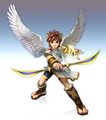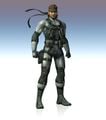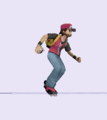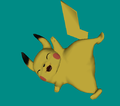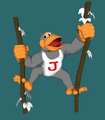Unused content (SSBB): Difference between revisions
No edit summary |
EndGenuity (talk | contribs) m (God dammit...) |
||
| Line 201: | Line 201: | ||
|snd_bgm_S09_BEATMANIA | |snd_bgm_S09_BEATMANIA | ||
|''Metal Gear'' | |''Metal Gear'' | ||
|Hypothesized to be ''Metal Gear'' universe music from | |Hypothesized to be ''Metal Gear'' universe music from ''[[wikipedia:Beatmania|Beatmania]]''. | ||
|- | |- | ||
|snd_bgm_T04_HOWTOPLAY | |snd_bgm_T04_HOWTOPLAY | ||
Revision as of 22:51, May 21, 2014
The following are beta elements found in Super Smash Bros. Brawl.
Beta gameplay
Some of the series symbols were initially the same as in the previous two games, but they were revised as time went on; the Mario series mushroom icon was refined and given spots, the Poké Ball icon has the top half colored in to properly represent how it is usually red, the Screw Attack icon was given more bends and another outline, and the Yoshi egg's angle was changed, with a slightly different arrangement of spots.
Multiple attacks were also changed between the game's development and release. Kirby's Hammer move is a well known example; in the E3 2006 trailer, he spins vertically when he uses the hammer in mid-air, much like in Melee. However, in the final build, he spins horizontally when he uses the hammer in mid-air. Unused animations also exist on the disc showing Kirby walking with the hammer still out, along with an animation of him swinging the hammer; this has been taken as a sign that the hammer Kirby uses was meant to be charged. This option was finally added in Super Smash Bros. 4.
In the Nintendo World 2007 trailer, when Fox appears, he has his Blaster in his hand during the whole battle despite the fact in the final release he only uses the blaster when using his standard special move. Additionally, animations left in the game data show both Fox and Falco inspecting the environment before putting their blasters away; they appear to have been intended for a mechanic where overusing the Blaster would cause it to overload or misfire.
Another early element is Link's Spin Attack. In the first and second trailers, it's given the appearance that there are two strikes on top of each other; in the final game, however, there is only one strike. The early Spin Attack also lacked the red overlay on the slashes.
Pikachu's Quick Attack was also altered; in the first trailer it's shown doing 2 "bip" sounds when it gets teleported, however, in the final version the sound from the move is different, and it only makes one sound, on the first teleport.
Snake, in particular, had many differences from the final product. For his grab, in some early pictures, he's shown grabbing some characters with more accuracy than in the final version. One picture shows Snake grabbing Ike from his right arm and mouth, but in the final version his grab move is shown with less accuracy, with every character being grabbed by the head. Snake's mines also were considerably more realistic-looking, sporting a drab, dark grey-green look instead of the light grey seen in the final game.
In trailers, characters were also shown to be KO'd via the colourful explosion when they crossed the upper blast line. In the final game, normal characters can only be KO'd this way in the Subspace Emissary.
E for All 2007 had a playable demo of Brawl available. This demo was lacking several starter characters: Kirby, Zelda/Sheik, Pokémon Trainer, Ice Climbers, King Dedede, Wario, Olimar, and Lucas are all starters in the final game, but were unavailable in the demo. The demo did, however, allow Sonic to be playable from the start.
By examining the textures of certain characters, it is shown that visible battle damage was at one point planned to be in the game, as evident by such unused textures as a Meta Knight mask texture with large gashes over his helmet and a cracked visor for Captain Falcon.
There also exists some unused Palette swaps for characters on the game's disc. One such unused costume was a blue-coloured Luigi, under the name FitLuigi02.pac/.pcs. Unusually, this costume has its shadow model integrated into the primary model, rather then having it as a separate model.
Beta stage design
Screenshots of early stage design are more difficult to find for Brawl than Melee.
Similar to the early screenshots for Melee, the initial Pokémon Stadium 2 had no graphics on the screen in the background.
Shadow Moses Island also had an outdoors area; while Snake can briefly be seen in it from the Nintendo World Report 2007 trailer, it can only be seen via hacked cameras in the final game.
In the E3 2006 trailer, Snake's Cardboard Box can be seen in the background of the stage when the Nintendog appears; this does not occur under normal circumstances in the final game.
Notice how the jumbotron behind Pokémon Stadium 2 is blank, while in the final that never happens during normal gameplay.
An early screenshot of Shadow Moses Island, depicting a location inaccessible in the final.
Beta single player elements
Multiple scenes in the Subspace Emissary were cut due to time constraints, which leaves some parts of the story out; however, an update on the DOJO!! explained these removed cut scenes. Among the explanations include how the Subspace Army takes over the Halberd and King Dedede unintentionally stalls Meta Knight from preventing it from happening.
A TV spot for Brawl also shows Mario instead of Kirby fighting Petey Piranha.
The font for enemies in the developing Subspace Emissary was slightly different and considerably more spaced out. Additionally, a early screenshot of "The Battlefield Fortress" shows a considerably less overcast and brighter sky.
An early classic mode screen appears in the ISO file as well. Unusually, it uses a sound effect from Melee.
In a screenshot of Brawl's Classic Mode on the DOJO!!, a battle against giant Meta Knight is depicted with two allies, whereas in the released version of Brawl, there is only one ally on the Kirby stage in a giant battle there. Additionally, no giant battles past stage two give the player two allies.
The Pokémon Trainer has unused jumping, falling, and landing animations that one can presume were intended to be used for traversing stages. In the final game, he simply Space Jumps when his Pokémon gets too far offscreen.
A file inferred to be part of controlling menu and display elements for the Subspace Emissary has been discovered to contains an unused display element, labelled "InfAdvLevel0000", which appears to display a level number and a bar labelled "pp" which is animated from full to empty in 50 frames. Based on other filenames its purpose appears to have been to display a level number before beginning the stage.
A less gloomy version of Battlefield Fortress.
Scrapped characters
Multiple unused character data files were found in the disc. Sometimes colloquially referred to as "The Forbidden Seven", they consist of:
- "dixie"
- "dr_mario"
- "mewtwo"
- "roy"
- "Pra_Mai"
- "toon_sheik"
- "toon_zelda"
The characters are believed to have been meant for inclusion, but were later scrapped. Similar to the various unused pieces of music found in Brawl's data, the identity of these characters can only be inferred from the filename. Despite this, it can be argued that there is less ambiguity over the identity of these characters:
- "dixie" can be reasonably assumed to be Dixie Kong, another character from the Donkey Kong Country series. No other data for the character, however, has been found, with the exception of her associated trophy.
- "dr_mario" can be reasonably assumed to be Dr. Mario, who appeared in Melee. Of note is that compared to the files for "mewtwo" and "roy", Dr. Mario has the least data available; the alternate costumes available for Wario in Brawl and the Wii Fit Trainer's two alternate costumes in Super Smash Bros. 4 has led to a new theory that claims the data was intended for use as an alternate costume for Mario.
- "mewtwo" can be reasonably assumed to be Mewtwo, who appeared in Melee. Of all the unused character files, "mewtwo" has the most data; in addition to an unused fanfare, "mewtwo" has a graphics effect file (
ef_mewtwo.pac) and a Wii Remote selection sound. As a result of this data, as well as being an arguably unjustified cut due to not being a clone, it has been suggested by some observers that Mewtwo was strongly intended for inclusion in Brawl, but was ultimately cut. - "roy" can be reasonably assumed to be Roy, who appeared in Melee. While lacking some data compared to "mewtwo", "roy" has an unused fanfare, suggesting the character was also strongly intended for conclusion in Brawl.
- The identity of "Pra_Mai" is unknown, though there are two common theories surrounding the character file:
- One possibility is that the data is for the Random Box on the character select screen, as its name loosely translates to "Every Player" in Japanese. This is, however, considered unlikely, as while Mai can mean "each" or every", the word for "player" in Japanese (Pureiyaa) would more likely be contracted to "Prei".
- Another possibility is that the file represents the Pokémon characters of Plusle and Minun, as their Japanese names are Prasule and Mainun. This, however, is also considered unlikely, as the tag team character of the Ice Climbers have separate character files for the two characters. In addition, as Mewtwo uses the official transliteration by Game Freak, this is unlikely, as Game Freak officially transliterates them as "Plusle" and "Minun".
- "toon_zelda" and "toon_sheik" can be reasonably assumed to refer to a cel-shaded Zelda that appeared in games such as The Legend of Zelda: The Wind Waker, much like the character of Toon Link. A cel-shaded variant of Sheik, however, never appeared in the Zelda series prior to Brawl's release, and as such, it is unknown how she was to be implemented.
The inclusion of the character files led to the formation of a rumor that was later proven false.
Data for an unused Ridley assist trophy also exists; it is believed to have been scrapped in favour of a boss version of Ridley. [1]
Beta names
Wario Bike, Drill Rush, Summit, Halberd, Rainbow Cruise, and "Flower Blooms in the Echoes" were originally called Wario Chopper, Triple Dash, The Summit, Battleship Halberd, Rainbow Ride, and, "Flowers Bloom on the Notes" respectively. It's unknown why they changed these names, although they likely changed Rainbow Ride because it was a Melee stage that had been misnamed "Rainbow Cruise" in that game (although it remains "Rainbow Ride" in the PAL regions, again because it was called "Rainbow Ride" on the PAL version of Melee).
Also, the description for the My Music options originally said, "Adjust how often a song will appear on this stage." It has since been revised in a general tone to say, "Adjust how often songs appear on stages." Along with this, one piece of music that was planned for the Delfino Plaza stage was later moved to Luigi's Mansion, that track being Castle / Boss Fortress (Super Mario World / SMB 3).
Finally, one minor change was made to the Friend roster before release. In a pre-release version of Brawl, the friend roster would display friends as "on-line" and "off-line", but in the final release, the hyphen was removed. This meant that the friend roster would instead display friends as "online" and "offline".
An early version of Delfino Plaza's My Music with a track later moved to Luigi's Mansion.
An early version of the sticker album.
An early version of the Friend roster.
Scrapped Masterpieces
In all versions of the game, a Masterpiece of Donkey Kong Country was to be included. It is believed the game was not included due to rights issues; Donkey Kong Country was initially made by Rareware.
In the American and PAL versions, Masterpieces featuring Fire Emblem: Monsho no Nazo and EarthBound are believed to have been planned to be included, as their data is found on the disc. Another theory, however, is that the games were simply leftover data from importing the data of the Japanese version.
Scrapped music
Within Brawl's game data, many unused and empty music files have been found on the disc. The reason that they were removed is unknown, though it is commonly believed that some tracks were removed due to copyright issues, limited space, or simply personal preference by the developers.
All track files in this list are "empty"; that is, attempting to play them does not produce any actual sounds. As this leaves only the filename to guess what the music was supposed to be, this can lead to ambiguity on what the song's identity is.
| File Title in Brawl's code | Category (based on prefix) | Song Identity Theories |
|---|---|---|
| snd_bgm_A11_MLRPG02 | Mario | Unknown track assumed to be from Mario & Luigi: Partners in Time. |
| snd_bgm_A12_MORINOKINOKO | Mario | Japanese translates to "Mushroom Forest"; due to its position in the list, which follows a general chronological trend, it is assumed this track was the theme for Toadwood Forest, also from Partners in Time. |
| snd_bgm_C06_KAZENOSAKANA | The Legend of Zelda | Japanese translates to "Ballad of the Wind Fish", a notable track from The Legend of Zelda: Link's Awakening, as well as an unrelated track from The Legend of Zelda: Majora's Mask. |
| snd_bgm_E04_COCKIE | Yoshi | Unknown track assumed to be from Yoshi's Cookie. |
| snd_bgm_G06_COMMAND | Star Fox | Unknown track assumed to be from Star Fox: Command. |
| snd_bgm_J01_STAGECHANGE | Fire Emblem | Assumed to be used for the stage transitions for Castle Siege. Others assume that it may have been a stage transition theme from a Fire Emblem series game, similar to "Preparing to Advance". |
| snd_bgm_J05_ERABARESHI | Fire Emblem | Assumed to be a shortened form of the Japanese "Erabareshimono" which translates to "Chosen Ones", a track from Fire Emblem: Monshō no Nazo. |
| snd_bgm_K02_SENTOUONIISAN | Mother | "Sentouonii-san" is the Japanese name for the New Age Retro Hippie, an enemy from EarthBound whose battle theme is similar to one from Mother, where a similar enemy also appeared. |
| snd_bgm_K03_EIGHTMELODIES | Mother | "Eight Melodies", a term describing two different tracks: one from Mother and one from EarthBound. |
| snd_bgm_K04_SMILEANDTEARS | Mother | "Smiles and Tears", the ending theme from EarthBound, which is based on the game's "Eight Melodies". |
| snd_bgm_K06_BECAUSE | Mother | Assumed to be "Because I Love You", a track from EarthBound. |
| snd_bgm_M14_WARIOSTAGE | Wario | Track of unclear origin in the Wario universe. |
| snd_bgm_N04_RADIOTAISO | Animal Crossing | The Japanese "Radio Taisou" translates to "Radio Exercises," a track from Animal Crossing. |
| snd_bgm_Q03_SPORTSMEDLEY | Miscellaneous songs | Assumed to be a medley of tracks from the generic sports titles on the NES, such as Soccer. |
| snd_bgm_R01_WILDTRACKS | Miscellaneous songs | Japanese name for the game Stunt Race FX; assumed to be a track from that game. |
| snd_bgm_S01_MAINTHEME | Metal Gear | Due to its placement in the filesystem of Brawl, assumed to be the main theme of a Metal Gear Solid game. |
| snd_bgm_S09_BEATMANIA | Metal Gear | Hypothesized to be Metal Gear universe music from Beatmania. |
| snd_bgm_T04_HOWTOPLAY | Super Smash Bros. | Assumed to be a duplicate file of the "How to Play" music. |
| snd_bgm_U05_UCANDO | Sonic the Hedgehog | Assumed to be "You Can Do Anything", a track from non-North American releases of Sonic CD. |
| snd_bgm_W22_DX55 | Super Smash Bros. | A removed track from Super Smash Bros. Melee -- the 55 may suggest that it was a rip of the Melee version of "Menu 2," track #55 in that game's Sound Test. Another hypothesis is that it was to be one of the other tracks from Melee to not be present in Brawl, such as Fourside or Yoshi's Story. |
| snd_bgm_W32_DX81 | Super Smash Bros. | Assumed to be another removed track from Melee. What the song was supposed to be specifically is currently unclear. |
| snd_bgm_X12_SIMPLEINTRO | Super Smash Bros. | Assumed to be used in the intros for Classic Mode |
| snd_bgm_X14_ENDING | Super Smash Bros. | Assumed to be used in the endings for Classic Mode. |
| snd_bgm_X24_HOW2PLAY | Super Smash Bros. | Assumed to be another track for the How to Play video. |
Along with the above music files, the following unused songs were also found in the data, intended for use in the Subspace Emissary:
- snd_bgm_Y06_ADV06
- snd_bgm_Y12_ADV12
- snd_bgm_Y18_ADV18
- snd_bgm_Y19_ADV19
- snd_bgm_Y20_ADV20
- snd_bgm_Y21_ADV21
- snd_bgm_Y22_ADV22
- snd_bgm_Y23_ADV23
- snd_bgm_Y24_ADV24
- snd_bgm_Y25_ADV25
- snd_bgm_Y26_ADV26
- snd_bgm_Y27_ADV27
- snd_bgm_Y28_ADV28
- snd_bgm_Y29_ADV29
- snd_bgm_Y30_ADV30
It is unknown if they were meant to be used as background music, or as fanfares.
Scrapped trophies
Some characters have unused trophies with "R2" in the filename, showing them in various poses (most in possible gameplay poses, some not). It is possible that these were intended to be a third trophy for each character, similar to how every character in Melee has three trophies, and the concept was scrapped for an unknown reason.
- Samurai Goroh UnusedTrophy Brawl.png
Samurai Goroh
Scrapped victory themes
Among the unused music files are various victory themes that are specifically attributed to one character, suggesting that characters were supposed to have their own victory theme independent of their series. In the final product, only Meta Knight has a different fanfare than other characters of his universe.
Of note is that two of these unused fanfares, snd_bgm_Z38_FMYU2 and snd_bgm_Z39_FROY, refer to two unused character files in the game.
The files are as follows:
- snd_bgm_Z09_FLUIGI
- snd_bgm_Z12_FKUOPA
- snd_bgm_Z13_FPEACH
- snd_bgm_Z14_FZELDA
- snd_bgm_Z15_FSHEIK
- snd_bgm_Z19_FFALCO
- snd_bgm_Z20_FGANON
- snd_bgm_Z24_FZEROSAMUS
- snd_bgm_Z26_FLUCAS
- snd_bgm_Z27_FDIDDY
- snd_bgm_Z28_FPOKETRAINER
- snd_bgm_Z32_FDEDEDE
- snd_bgm_Z33_FLUCARIO
- snd_bgm_Z34_FIKE
- snd_bgm_Z37_FPURIN
- snd_bgm_Z38_FMYU2
- snd_bgm_Z39_FROY
- snd_bgm_Z41_FTOONLINK
Along with this, there are two other unused fanfares, snd_bgm_Z52_JCLEAR1 and snd_bgm_Z53_JCLEAR2; their intended use is unknown.
Scrapped enemies
Amongst text data for enemy names, a few unused names exist, implying enemies that were cut. These names are:
- Melorin
- Mechaboom
- Bublit
- Blowm
- Plowm
- Aliians
- Aliian
Mizzo is also included in this list.
